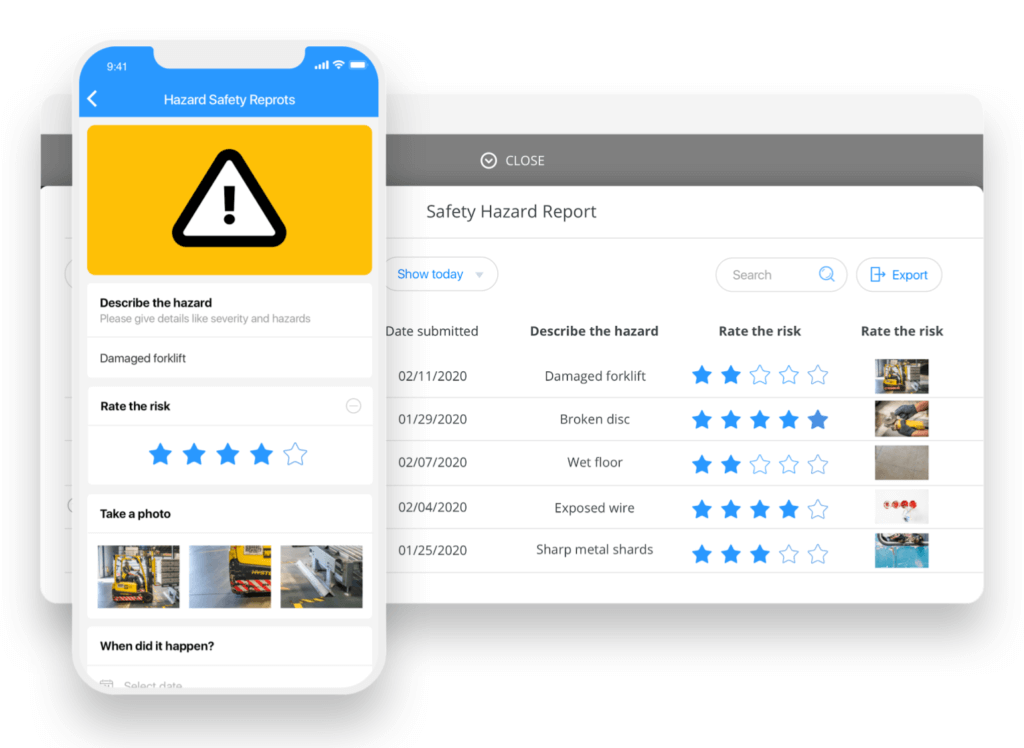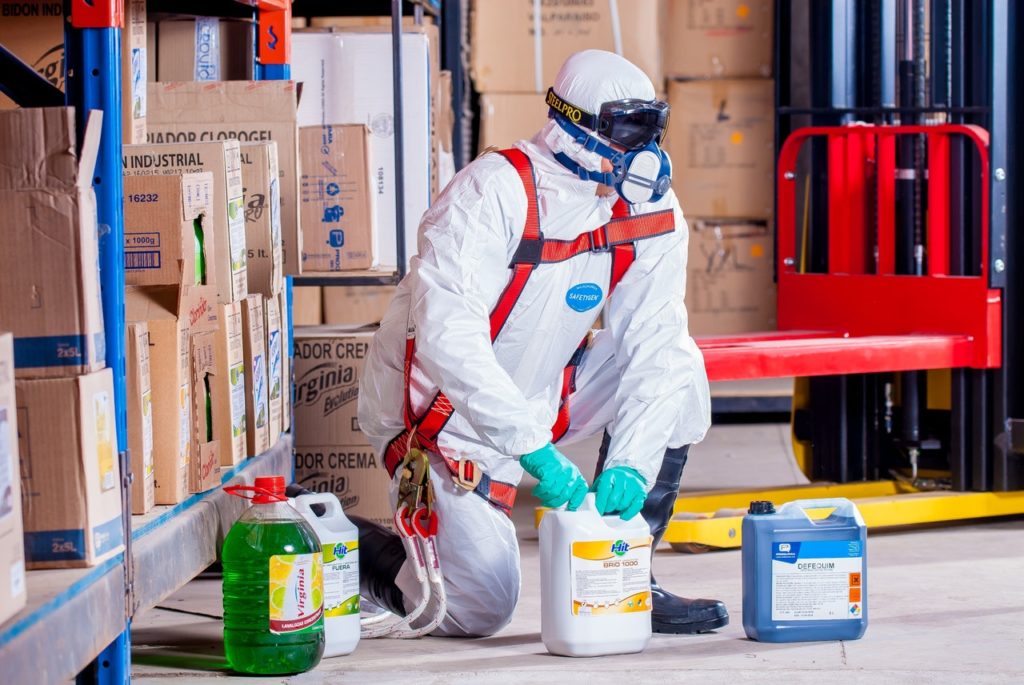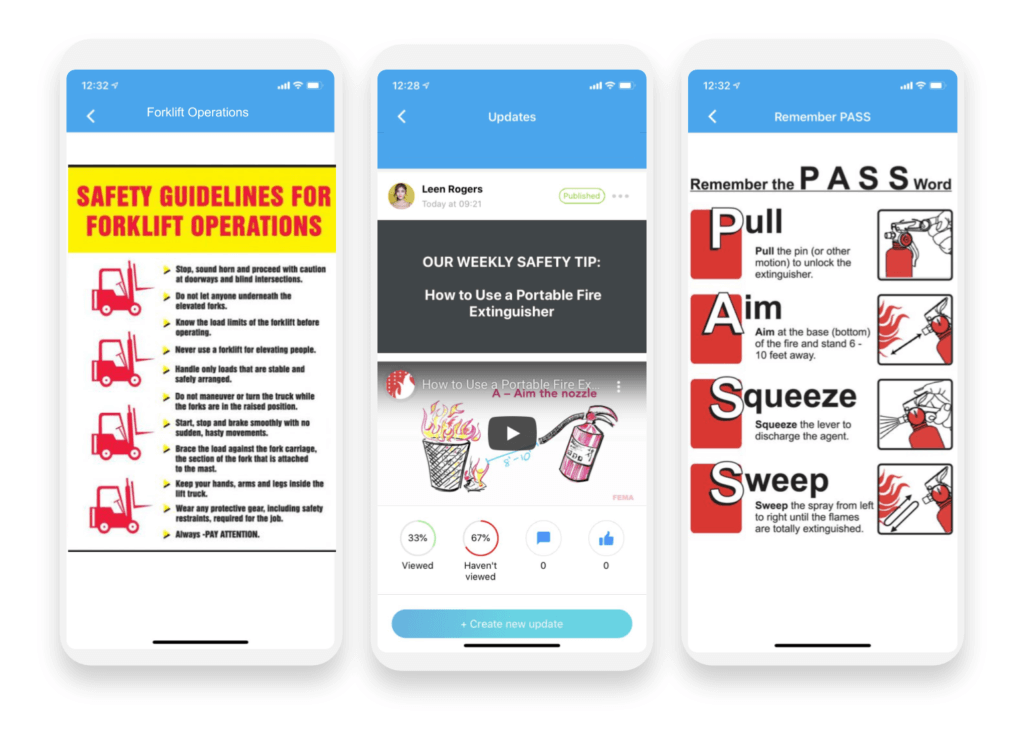Table of contents
- Report Unsafe Conditions ASAP
- Follow The Latest Safety Procedures
- Don’t Take Shortcuts
- Take Regular Breaks
- Set & Follow Emergency Protocols
- Reduce Workplace Stress
- Make Safety Gear A Must
- Follow Ergonomics Standards
- Follow Industry Standards
- Have A “Safety Squad”
- Conduct Safety Surveys
- Move Around
- Go Digital For Effective Workplace Safety
- The Bottom Line On Workplace Safety
As someone who has spent the last decade working in office buildings and recently from home, I don’t stake workplace safety as a necessity. But, if you were to ask a frontline worker, safety would rank as one of their top three must-haves.
Here’s the thing, workplace safety is one of the biggest concerns for any business, and rightfully so. In 2019 alone 2,836 work-related fatalities were reported to OSHA (Occupational Safety and Health Administration).
Additionally, there were around 2.8 million nonfatal workplace injuries and illnesses reported to OSHA. With numbers like this, it’s no wonder that many companies, especially those with deskless and frontline workers, are in need of safety tips for work.
And if workplace safety wasn’t already hard enough, 2020 brought brand-new challenges into the mix. Due to COVID-19, organizations faced substantial shifts throughout their workplace. In just a few short months, companies had to switch from optimizing customer relationships to rebuilding their entire employee management structure. In such conditions, issues like returning to work safely, and overall workforce readiness became a major concern.
The COVID-19 crisis continues to force employers and managers all over the world to get creative and adapt to these new workplace safety challenges.
Many have recognized the need of providing sufficient levels of training and onboarding for new employees, and even veteran team members, to guarantee workplace safety for their people, and legal compliance. This is a tall order for sure, but one that can be managed especially if you’re keeping up with the 21st century. That’s right, managers of all field service industries are turning to online training software and safety checklists and workflows to help workers stay alert and ready, reduce the risk of incidents.
Most commonly, they’re able to quickly handle the following in the click of a button instead of endless, mindless pen and paper documents or Excel spreadsheets:
- Raising Safety Standards and Awareness
- Day-to-Day Digital Reporting and Checklists
- Streamlining Communication to Deskless Employees
- Making SOPs and Company Protocols Available
- Human Resources needs
- Compliance Purposes
- Remote Training Opportunities
Using dedicated modern software solutions for employee management for immediate reporting and consistent workplace safety control will raise the overall safety standards and help increase the flawless production performance rates.

#1 Workplace Safety Software
All-in-one app for easily creating & populating safety policies, sending important updates in real-time, collecting field incident reports & fill-and-sign checklists. All this & more!
This blog will describe key workplace safety tips to know in 2022, and how a digital workforce management solution can help establish a proactive process to enhance workplace safety, security, and compliance across the workforce while driving additional productivity. These are the workplace safety tips that every employee should know.
Report Unsafe Conditions ASAP
Fixing unsafe conditions and preventing bad things from happening starts with YOU. Employees must report unsafe conditions to their managers as soon as they notice something isn’t right. Managers are legally obligated to create a safe working environment so if you report something as unsafe, they have to correct it as soon as possible. From wet floors to a ladder that is slightly bent and more, make sure you speak up so you can create a safe workplace for yourself and your colleagues.
TIP: Using mobile checklists and forms apps allows you to report unsafe conditions in real-time so your manager can correct the issue straight away. Plus, by digitizing your incident reports you have the ability to send immediate updates to all employees alerting them to the problem and how to avoid injury.
Follow The Latest Safety Procedures
Whether your company purchases new equipment or just updates safety procedures, you must know the new safety procedures and safety topics for work associated with the change.
For example, just in October 2020, (OSHA) issued temporary guidance on enforcement of initial and annual fit-testing requirements in the Respiratory Protection Standard for Powered Air Purifying Respirators (PAPRs). Enforcement discretion for this specific protocol is limited to healthcare personnel or other workers engaged in high- or very high-exposure-risk activities, but it’s important that every employee will receive all the safety updates and explanations regarding new regulations.
TIP: Make sure you fully understand the new protocol and ask questions for clarification. A mobile training app allows you to receive training updates immediately and your manager can create a quiz to ensure you understand the changes.
Don’t Take Shortcuts
Workplace safety and handling procedures exist to keep your employees safe, especially those when involving heavy machinery. It is essential to use each tool and machine according to instruction, shortcuts will only cause injury and just aren’t worth the few minutes you may save. So, be sure you’re using the right tool, the correct way.
As an employer or employee manager, it is your moral and legal obligation to make sure the conditions at the workplace are safe, and every employee is well aware and trained properly before they start the actual work. That’s why investing the time and money in a thorough workplace safety training program can save you a lot of money and grey hair on churn, sick leave, and medical insurance payments, in the long run.
Research from Toronto’s Institute for Work & Health shows that workers who had been at a job for a month or less had three times the risk of suffering a lost-time injury compared to those who had been at a job for over a year.
Additionally, a lack of experience can lead to a new worker not fully understanding or evaluating risks while on the clock, thus putting new employees and those around them at additional risk.
TIP: Follow your obligations to ensure workplace conditions are safe or risk costly lawsuits, high turnover, and a ruined reputation. (A bit harsh, I know, but workplace safety is not something to joke about.)
Take Regular Breaks
Taking regular breaks is not just required by OSHA but it’s just common sense too. The entire reason that OSHA included the regular breaks is common sense, when workers are tired, they’re more prone to incidents because awareness of their surroundings is hampered by exhaustion. Taking breaks on a regular schedule helps keep employees fresh and alert.
TIP: With an employee scheduling app, you can send automated reminders to encourage your employees to take a break! Ideas include getting some fresh air, stretching, having a glass of water, and so on.

Set & Follow Emergency Protocols
Emergencies don’t often announce themselves, like fire, floods, or tornados for example. So you must be prepared for everything in your region that can disrupt safety to your company, your employees, and your customers. As far as safety topics for work go, emergency protocols are a no-brainer.
Therefore, have procedures in place if an emergency should happen:
- Anticipate natural disasters and similar emergencies by checking social media alerts and the Weather Channel.
- Ensure your insurance is in check.
- Identify risks to your company.
- Identify crucial points to your company and how to effectively protect them.
- Create an emergency management plan.
- Make sure your employees complete Emergency Response and Evacuation Training.
In other words, your job as an employer is to identify anything that your employees can be exposed to and create a clear process on what to do in case of an incident.
Most categories have OSHA-certified guidelines that are typically consistent across industries so customize your protocols to these procedures. After all the risks are identified, prepare digital checklists for your employees based on that, such as:
- Safety hazard observation
- Incident report
- Vehicle accident report
- Safety inspection form (for supervisors)
- Repair order ticket
- QA checklist
- Safety inspection checklist
TIP: It’s proven that when employees go through a checklist when arriving at the job site or before using equipment, the chances of incidents or injuries drop dramatically. And when that checklist is easily and readily available on their mobile phone, chances are referring to the checklist increase dramatically.
Boost Workplace Safety with a Digital Checklist App
Reduce Workplace Stress
The American Physiology Association has linked job stress to health problems, burnout, workplace accidents, and more. Employers must take steps to prevent stress from interfering with an employee’s productivity and well-being. An EAP (Employee Assistance Program) can be highly beneficial.
You must identify any risks and threats that your employees can be exposed to (both physically and emotionally) in order to create a safe work environment and easy reporting opportunities.
TIP: Read our guide on how to make work less stressful so that your team is engaged and productive.
Make Safety Gear A Must
When I worked at the bakery, there was numerous safety gear we were required to wear. For example, non-slip shoes, cut-resistant gloves, etc. (If only I could list that hairnet as safety gear!)
Proper safety gear is a must when it comes to workplace safety, whether you’re operating machinery or working with hazardous materials.
As mentioned, proper footwear is just as necessary as well as it prevents you from slipping or falling.
TIP: Employees must sure to ask their employer what the proper protective gear is when handling a certain job and if they will provide the clothing needed. Additionally, managers should hand signs that clearly state if you need special gear to execute a certain task.
Follow Ergonomics Standards
Ah, now here is a true workstation safety tip for my remote and office workers!
Ergonomics refers to adjusting the job to suit an employee’s physical needs. Such as the office ergonomics, workspace design, and the work environment to help maintain productivity and safe working conditions. From standing at a machine all day or sitting at a computer desk, the equipment should be at the proper height to avoid straining one’s neck. Keyboard height can even affect the back, shoulders, and wrists.
TIP: Be sure to follow this particular safety topic for work and ensure your workstation is designed to suit your needs.
Follow Industry Standards
Make sure that your employer is complying with all the proper standards, it’s important that you’re aware and up to date on the standards are for your industry. Think of it like this, OSHA has strict standards when working with hazardous materials, therefore it’s incredibly important that you use material safety data sheets (MSDS) for hazardous substances. If you believe your employer isn’t complying with or meeting these standards, you must go to human resources right away.
TIP: If you’re an employer — make sure to create a checklist that also includes hazards like fire, electrical, and ergonomic, you can find sample programs from the Occupational Safety and Health Administration (OSHA) website to know exactly what topics to cover.

Have A “Safety Squad”
Rely on your staff to help find solutions to workplace safety issues. Consider assembling a five or six-person “Safety Task Force” whose job is to review the company’s safety manual. Not to mention, the building, property, and internal protocols which are focused on keeping offices, clients, and employees safe.
When you ask your employees directly what they feel could lead to certain problems, it can help open your eyes to problems you were blind to.
TIP: When employees lead the safety processes, from management to the field, everyone is involved in every part of the company’s safety efforts so hazard reporting and corrective actions are on all staff members to execute. This kind of safety culture helps build ownership across the entire company. In addition, involving your employees helps them feel more recognized and safer once procedures are implemented.
Conduct Safety Surveys
On a regular basis, the cadence is up to you. Once a month, per quarter, or every six months, issue a safety survey.
The survey should cover:
- how employees feel about management’s commitment to safety
- the effectiveness of safety training
- if it’s easy to report concerns
- etc.
TIP: Review the insights your employees share so that you know which procedures need improvement and areas of concern.
Move Around
The U.S. pays $100 billion each year in medical bills, lost work time, and other costs because one in four occupational injuries is related to low-back-strain. Some of these strains relate to lifting and twisting, but that isn’t always the case. Sometimes it’s about poor posture, like extended sitting in compromised positions. As such, encourage your employees to stand up more (consider sit-stand desks) and to walk around.
Take a 5-minute break every hour to just get up and move around can be highly effective.
TIP: Workplace safety isn’t something employees should have to think about just during training workshops or drills. Instead, it’s more effective to include workplace safety in the company culture by encouraging everyone to be accountable for maintaining a safe workplace. Together, all of you can reduce the number of accidents and injuries.
Go Digital For Effective Workplace Safety
If you’re still thinking of how to keep your workplace safe then here’s a simple tip – join the 21st century! With a digital solution, you are able to deliver safety in real-time. Countless frontline industries are turning to Connecteam to raise safety standards, enhance compliance company-wide, streamline daily processes and so much more.
So, what features does Connecteam offer to help you enhance workplace safety?

- On the go reporting makes it easy for employees to send report in real-time. These reports are automatically sent to the relevant officer or supervisor so they can further evaluate and respond as needed. Plus, employees can add pictures, notes, a voice note, etc. so you have the full picture.
- Share and store resources on the app so that all safety protocols, procedures, tips, and resources are available for your employees whenever they need.
- Ongoing training is delivered with videos, chapters to read, quizzes and more.
- Share update or start a group chat to send out announcements of hazards, policy changes, new safety protocols, etc.
- All SOPs and company protocols are directly available on the app. Like the Standard Operating Procedures (SOPs), safety and emergency protocols, employee handbook, code of ethics, etc.
Connecteam makes it easy for you to ensure you have a safe workplace environment for your staff! Get started for free now.
The Bottom Line On Workplace Safety
OSHA’s regulations and rules are important, but true workplace safety starts with the idea of each employee’s personal responsibility, cemented into the company culture. When your employees are well-trained and familiar with all the latest workplace safety standards, they are ready to identify unsafe conditions and possibly avoid accidents or respond quickly and correctly if they happen.
More importantly, involve every employee in the collective workplace safety and grant them the right to raise flags and take responsibility for themselves and their colleagues as often as possible.
